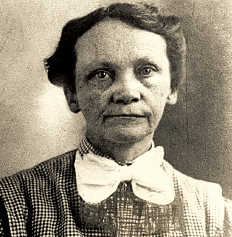At the beginning of the 20th century, Amy Duggan Archer Gilligan operated a home for the elderly in Windsor, Connecticut. Having spent a significant portion of her professional life caring for those who could not care for themselves, she established a facility where, in return for lump sum payments or for signing over insurance policies, residents received a lifetime of care. The problem was, after only a handful of years in operation, an inordinate number of Gilligan’s clients began turning up dead.
Born in 1873, Amy Duggan married James Archer in 1896. Five years later, Newington widower John Seymour hired the couple as live-in caretakers. After Seymour’s death in 1904, the Archers remained in the home as renters who made a living caring for elderly boarders. In 1907, the Seymour family sold the home and the Archers moved to Windsor to open the Archer Home for Aged People.
Amy Duggan Archer Gilligan Comes Under Suspicion
The Archers ran the home together until 1910, when James Archer died of kidney failure. By then, Amy Duggan Archer was a fixture in the local community. She was active in Windsor affairs and even donated a stained-glass window to the local church. According to residents of the town, however, she seemed to purchase unnecessarily large quantities of arsenic to control a rat problem she claimed to have at the nursing home.
In 1913, Amy married Michael Gilligan, but he died a mere 3 months into their union. His death was just one of many plaguing Gilligan’s facility. Between 1907 and 1916, 60 residents died at the home, 48 of them in the prior 5 years alone. One death in particular, that of Franklin Andrews, seemed to raise some suspicion about Gilligan’s operation.
One day after working on the lawn around the house and appearing in perfect health, Franklin Andrews died. After going through his papers, Andrews’s sister found information regarding a $500 loan to Gilligan, so she contacted authorities. Although the district attorney initially showed little interest in the case, the Hartford Courant began an investigation that ultimately led to Gilligan’s arrest in 1916.
Serial Killings Inspired the Dark Comedy of Arsenic and Old Lace
The trial began in June of 1917 and lasted 4 weeks. Authorities exhumed bodies and found traces of arsenic in the systems of more than 2 dozen of Gilligan’s former residents. It only took 4 hours for a jury to convict Gilligan of operating, what the Hartford Courant labeled, a “murder factory.”
Sentenced to death by hanging, Gilligan appealed and had her conviction overturned on a technicality. During the course of a second trial, which began in June of 1919, Gilligan pleaded guilty to a reduced charge of second-degree murder and received a sentence of life in prison. After spending time incarcerated in Wethersfield, authorities deemed Gilligan “insane” and sent her to the state mental hospital in Middletown. She died there in 1962 at the age of 89.
In the decades prior to Gilligan’s death, however, her story both fascinated and horrified the American public. One particular follower of Gilligan’s case, a New York playwright named Joseph Kesselring, decided to take Gilligan’s story and rewrite it as a comedy. His very successful play ran on Broadway from 1939 until 1944 under the title, “Arsenic and Old Lace.” Frank Capra adapted the play for the silver screen. The film, Arsenic and Old Lace starring Cary Grant, debuted in 1944 after the play concluded its Broadway run.











